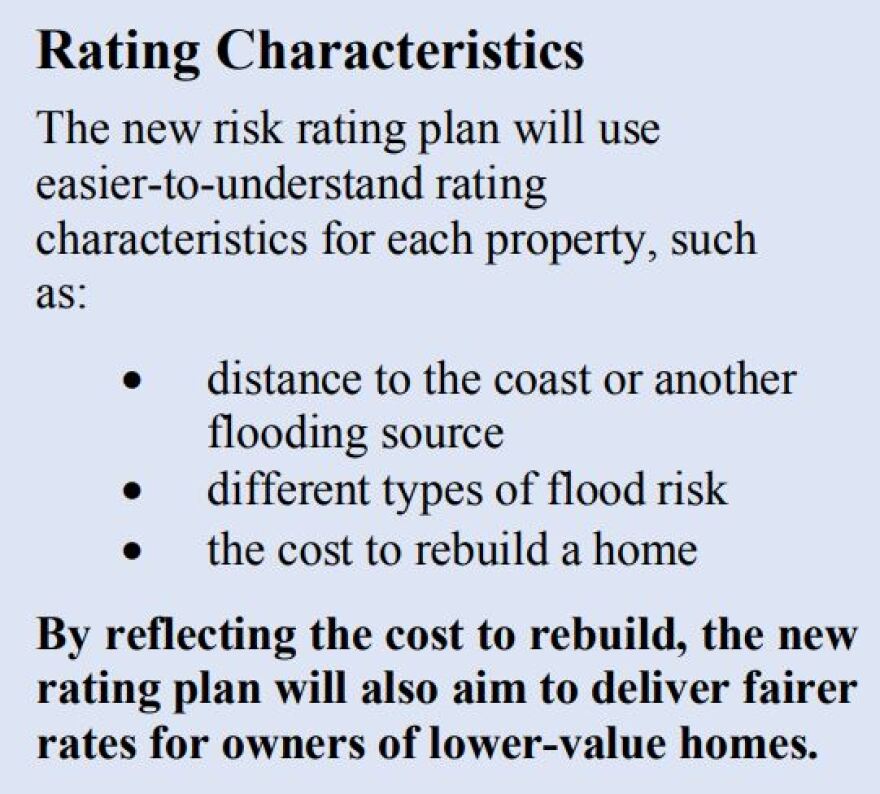As Congress debates how to manage flooding and pay for damages, a federal agency plans to change the way flood insurance rates are calculated. It'll affect how much homeowners pay in premiums. And it may reduce the burden on taxpayers who frequently have to bail out the National Flood Insurance Program.
Michelle O'Neill reports next year,* the program will implement what FEMA officials call, Risk Rating 2.0.
For decades, the Federal Emergency Management Agency has based flood insurance rates on one factor - whether a home is located in or out of a flood plain.

David Maurstad is the Chief Executive of the National Flood Insurance Program. He says not nearly enough people have flood insurance. They may not know homeowners insurance doesn't cover damage from flooding.
Only 30% of homeowners and renters in high risk areas are covered. And only 4% outside high risk areas are covered.
People also don't understand how the agency calculates a property's flood risk. The current method can be inaccurate and unfair. Maurstad says Risk Rating 2.0 will incorporate best practices to help fix those problems, using lots of data, plus new technology, taking into account different types of floods, a property's distance to a body of water, and the cost to rebuild a specific home.
He says FEMA is also addressing an inequity created in the 1970s. Most owners of lower value homes pay proportionately more than owners of higher value homes.

Lynne McChristian is the spokeswoman for an industry group called the Insurance Information Institute. She agrees the program's flood risk rating system must change because they're underpriced.
She says the proof is the program is $30 billion in debt which is not sustainable with floods occurring more frequently.
Private insurance companies would quickly go out of business using the federal government's pricing model. And McChristian says you can guess who pays the debt - taxpayers.
FEMA plans to implement Risk Rating 2.0 in October, 2020 for single family homes. But it's only a small part of the solution.

Reform of the entire National Flood Insurance Program came up repeatedly at a recent Congressional re-authorization hearing.
Wisconsin Representative Sean Duffy said last year, expenses outstripped revenue by $6.6 billion. And Congress forgave $16 billion dollars of its debt.
*Note: As of 11/15/2019, FEMA has decided to implement NFIP 2.0 one year later than originally announced. The following information is copied directly from an article on FEMA's website:
"Risk Rating 2.0 Implementation Has Been Deferred To October 1, 2021"
"While the agency initially announced that new rates for all single-family homes would go into effect nationwide on October 1, 2020, some additional time is required to conduct a comprehensive analysis of the proposed rating structure so as to protect policyholders and minimize any unintentional negative effects of the transition."

"Therefore, FEMA decided to defer the implementation of Risk Rating 2.0 by one year to October 1, 2021. Additionally, this extension also allows for all National Flood Insurance Program (NFIP) policies – including, single-family homes, multi-unit and commercial properties – to changeover to the new rating system at one time instead of a phased approach, as originally proposed."
"Over the course of the next year, FEMA will continue to actively engage with Congress and other key stakeholders to ensure transparency and visibility as we work to transform the NFIP."
"If you have questions, please send an email to, FEMA-NFIP-INSURANCE-TRANSFORMATION@fema.dhs.gov."






